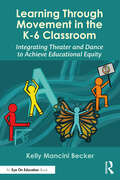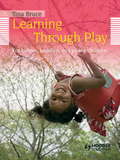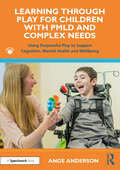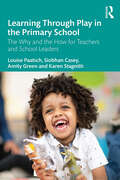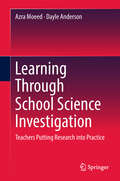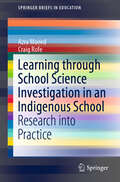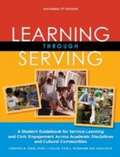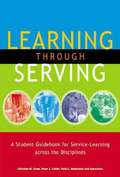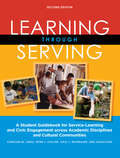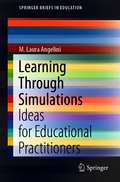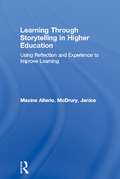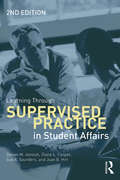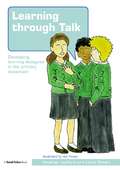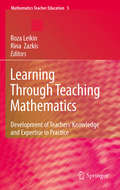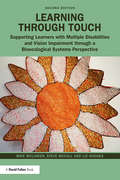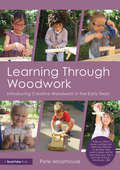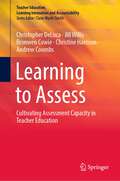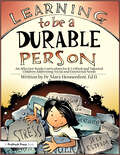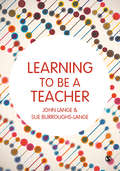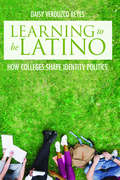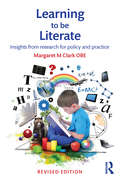- Table View
- List View
Learning Through Movement in the K-6 Classroom: Integrating Theater and Dance to Achieve Educational Equity
by Kelly Mancini BeckerThis book offers a creative and practical guide for K-6 teachers on how to effectively integrate movement into the curriculum to increase student engagement, deepen learning, improve retention, and get kids moving during the school day. Chapters offer concrete ideas for integrating creative movement and theater into subjects such as math, science, literacy, and social studies. Drawing on two decades of experience, Dr. Becker outlines key skills, offers rich examples, and provides adaptable and flexible classroom tested lesson plans that align with Common Core Standards, the NGSS, C3 Social Studies Standards, and the National Core Arts Standards. Activities are grounded in arts integration, which is steadily gaining interest in school reform as an effective teaching strategy that increases student outcomes academically and socially—particularly effective for students who have traditionally been marginalized. This book will benefit practicing educators who want to invigorate their practice, preservice teachers who want to expand their toolkit, and school leaders looking to employ policies that support movement and arts during the school day. Jump in and get your kids Learning Through Movement and see how active and engaging learning can be!
Learning Through Movement in the K-6 Classroom: Integrating Theater and Dance to Achieve Educational Equity
by Kelly Mancini BeckerThis book offers a creative and practical guide for K-6 teachers on how to effectively integrate movement into the curriculum to increase student engagement, deepen learning, improve retention, and get kids moving during the school day.Chapters offer concrete ideas for integrating creative movement and theater into subjects such as math, science, literacy, and social studies. Drawing on two decades of experience, Dr. Becker outlines key skills, offers rich examples, and provides adaptable and flexible classroom tested lesson plans that align with Common Core Standards, the NGSS, C3 Social Studies Standards, and the National Core Arts Standards. Activities are grounded in arts integration, which is steadily gaining interest in school reform as an effective teaching strategy that increases student outcomes academically and socially—particularly effective for students who have traditionally been marginalized.This book will benefit practicing educators who want to invigorate their practice, preservice teachers who want to expand their toolkit, and school leaders looking to employ policies that support movement and arts during the school day. Jump in and get your kids Learning Through Movement and see how active and engaging learning can be!
Learning Through Play
by Tina BruceProfessor Tina Bruce CBE, an acknowledged expert on play, clearly presents the key ideas and demonstrates the best practices for cultivating play in an Early Years setting. The book covers historical perspectives, how we can observe and study play, and the role of play in learning, developing abstract ideas, helping children to relate to one another. She shows that play helps children to achieve the highest form of learning in early childhood. This new edition of Learning Through Play will provide students and practitioners with an invaluable guide to the core values behind play, the importance of play for children from 0 to 5 years old, and practical schemas for getting the best out of play in an Early Years or Educational setting. It will be an ideal text for those studying play at levels 3 and 4, Foundation Degrees, Undergraduate Early Childhood Studies and Primary Education courses, Post-graduate study and for those working in an Early Years setting.
Learning Through Play for Children with PMLD and Complex Needs: Using Purposeful Play to Support Cognition, Mental Health and Wellbeing
by Ange AndersonThis book examines the development of play skills and schemas to support children with learning differences and physical disabilities in learning to play. It highlights the need for appropriate playground equipment in all school settings that educate children with physical disabilities and sensory needs to ensure equal opportunities for outdoor play. Several play approaches for meeting sensory needs are discussed including Lego therapy, Art therapy, Sand play and Soft play. Digital play for students with physical disabilities is an important chapter in the book. Role play and the ways in which virtual reality and psychodrama support anxieties that some students have is another important chapter. There is also a chapter devoted to parents on how they can support their child at home and how the school can support them. At the end of the book there is a plethora of resources that readers can copy or adapt to suit their setting. The book provides support for those managing outdoor play for these children at peak times of the day. It shows how play-based learning can work in a classroom setting; the importance of sensory profiles and sensory play; and how play therapy can aid neuroplasticity.
Learning Through Play in the Primary School: The Why and the How for Teachers and School Leaders
by Louise Paatsch Siobhan Casey Amity Green Karen StagnittiDrawing on research to inform practice, this book is written for teachers and school leaders looking for guidance on how to successfully implement a play-based curriculum in the early years of primary school. Learning Through Play in the Primary School unpacks the "why" and the "how" of embedding play-based pedagogies in the first three years of school. The book is divided into two sections, the first drawing on the latest research to outline the importance of play in a child’s development and emotional engagement in learning. The second section provides practical support and examples for how to embed play in a school curriculum to enhance young children’s learning. The practical section covers setting up an environment for guided play, demonstrating how to assess learning from play-based activities and how to report on outcomes, supported by checklists, vignettes, and case studies. Written to facilitate the implementation of play-based learning in the primary school years, this book will be an essential guide for pre- and in-service teachers and school leaders.
Learning Through School Science Investigation: Teachers Putting Research Into Practice (SpringerBriefs in Education)
by Dayle Anderson Azra MoeedThis book explores teaching and learning through science investigation and practical work. It draws upon two representative case studies from New Zealand and examines what students are learning from science investigation; in addition, it identifies and describes ways in which teachers can make changes that benefit student learning when given time to reflect and respond to research literature and findings. The book illustrates how teaching through science investigations in ways that are informed by research can lead to positive learning outcomes for students. As such, it offers valuable insights for practitioners, researchers, and educators with an interest in learning through science investigation.
Learning Through School Science Investigation in an Indigenous School: Research into Practice (SpringerBriefs in Education)
by Azra Moeed Craig RofeThis book presents the findings of a case study conducted in a Māori medium school where a space was created for Pūtaiao (Western science) teaching and learning from year 1 to 13. Science is currently taught in Te Reo Māori in primary school and in English in secondary school, and evidence suggests that students are engaging in science education, learning to investigate, and achieving in science. In New Zealand, most students attend English medium state schools; however, approximately 15% of indegenous students attend Māori medium schools. These schools are underpinned with Kura Kaupapa Māori philosophy, which is culturally specific to Māori and aims to revitalise the Māori language, and Māori knowledge and culture. Māori students’ engagement and achievement continues to be a challenge for both mainstream and Māori medium schools, teachers and students due to lack of access to science teachers who can teach in Te Reo Māori. School leaders and whanau (families) believed that by year 9 (age 13) their students had developed their identity as Māori, and were proficient in Te Reo Māori. They wanted their students to have the option to learn science, experience success and have the choice to conitnue in science, so they made the difficult decision for science to be taught in English in secondary school. The book discusses how teachers in indigenous schools, who have extensive knowledge of culture and context specific pedagogies, can gain confidence to teach science through collaboration with and support from researchers with whom they have developed strong professional relationships.
Learning Through Serving: A Student Guidebook for Service-Learning and Civic Engagement Across Academic Disciplines and Cultural Communities
by Christine M. Cress Peter J. Collier Vicki ReitenauerUnderstanding the Learning-Throught-Serving Proposition Learning the Landscape, Learning the Language Facilitating Learning and Meaning-Making Inside and outside the Classroom Assessing the Engagement Effort
Learning Through Serving: A Student Guidebook for Service-Learning Across the Disciplines
by Christine M. Cress Peter J. Collier Vicki L. ReitenauerThis book is intended as a self-directed guide for college-level students who are engaged in service-learning. It is also suitable for students working individually.
Learning Through Serving: A Student Guidebook for Service-Learning and Civic Engagement Across Academic Disciplines and Cultural Communities
by Christine M. Cress Peter J. Collier Vicki L. ReitenauerThis substantially expanded new edition of this widely-used and acclaimed text maintains the objectives and tenets of the first. It is designed to help students understand and reflect on their community service experiences both as individuals and as citizens of communities in need of their compassionate expertise. It is designed to assist faculty in facilitating student development of compassionate expertise through the context of service in applying disciplinary knowledge to community issues and challenges. In sum, the book is about how to make academic sense of civic service in preparing for roles as future citizen leaders. Each chapter has been developed to be read and reviewed, in sequence, over the term of a service-learning course. Students in a semester course might read just one chapter each week, while those in a quarter-term course might need to read one to two chapters per week. The chapters are intentionally short, averaging 8 to 14 pages, so they do not interfere with other course content reading. This edition presents four new chapters on Mentoring, Leadership, Becoming a Change Agent, and Short-Term Immersive and Global Service-Learning experiences. The authors have also revised the original chapters to more fully address issues of social justice, privilege/power, diversity, intercultural communication, and technology; have added more disciplinary examples; incorporated additional academic content for understanding service-learning issues (e.g., attribution theory); and cover issues related to students with disabilities, and international students. This text is a student-friendly, self-directed guide to service-learning that: Develops the skills needed to succeed Clearly links service-learning to the learning goals of the course Combines self-study and peer-study workbook formats with activities that can be incorporated in class, to give teachers maximum flexibility in structuring their service-learning courses Promotes independent and collaborative learning Equally suitable for courses of a few weeks’ or a few months’ duration Shows students how to assess progress and communicate end-results Written for students participating in service learning as a class, but also suitable for students working individually on a project. Instructor's Manual This Instructor Manual discusses the following six key areas for aligning your course with use of Learning through Serving, whether you teach a senior-level high school class, freshman studies course, or a college capstone class: 1. Course and syllabus design 2. Community-partner collaboration 3. Creating class community 4. Strategic teaching techniques 5. Developing intercultural competence 6. Impact assessment
Learning Through Simulations: Ideas for Educational Practitioners (SpringerBriefs in Education)
by M. Laura AngeliniThis book is written for teacher educators who are looking for strategies to teach a foreign or second language in a more meaningful way whilst applying active methodologies to develop critical thinking skills. The book is designed to guide the readers through a series of simulations that provide challenging learning opportunities, similar to the ones experienced in real life, whereby each simulation is designed to support participants’ language and critical thinking skills and their abilities as future teachers. The book first introduces the concept of simulations in education. Then it provides examples of fully developed simulations and instructions for their implementation, a template for the readers to create their own simulations, as well as suggestions for peer classroom observation and professional development. Finally, three case studies exploring student learning through simulations are presented. This book is a useful teaching resource for teacher instructors, English as a Second Language/English as a Foreign Language students, secondary school teachers and for language institutions.
Learning Through Sounds Grade 1 (Medieval Mysteries #1)
by Pathway PublishersThis workbook has been prepared especially for first graders in Amish parochial schools. Pictures have been carefully chosen to be of objects the average Amish child is familiar with. Not only was the book prepared with the children in mind, their teacher was also considered. Though children need a certain amount of teacher help to master the skill of sounding out words, this workbook has been designed so that the children will soon be able to work without much teacher assistance. You will notice there are no instructions included with the exercises in this book. You will find detailed instructions, plus a wealth of supplementary exercises in the 'Teachers' Manual for Grade One Readers." We would like to encourage teachers to follow the instructions given in the manual, then let their own imagination and that of the children lead them in deeper and more detailed lessons in phonics.
Learning Through Storytelling in Higher Education: Using Reflection and Experience to Improve Learning
by Maxine Alterio Janice McDruryLearning Through Storytelling in Higher Education explores ways of using storytelling as a teaching and learning tool. When storytelling is formalized in meaningful ways, it can capture everyday examples of practice and turn them into an opportunity to learn - encouraging both reflection, a deeper understanding of a topic and stimulating critical thinking skills. The technique can accommodate diverse cultural, emotional and experiential incidents, and may be used in many different contexts eg formal/informal; one-on-one/group setting.The authors outline the different models of storytelling and explain how to make use of this technique and encourage a 'storytelling culture' within the workplace or in tutorial sessions.Academic yet accessible, this book provides a new perspective on learning techniques and will be a great asset to any educator looking to improve reflective practice.
Learning Through Supervised Practice in Student Affairs
by Diane L. Cooper Steven M. Janosik Joan B. Hirt Sue A. SaundersFor future student affairs professionals and higher education administrators, the supervised practice experience is where theory learned in the classroom is put into practice. Learning through Supervised Practice in Student Affairs assists students in applying leadership, advising, conflict management, and planning skills to their practice. This important book explores the theories that foster learning and understanding of higher education organizations while exercises, reflection activities, and case studies illuminate the skill areas that students must develop to become successful practitioners. This Revised Edition Includes: Reflection activities to engage students and foster critical thinking Expanded attention to diverse populations and cultural differences Updated legal references and case law related to daily practice Broadened discussion of professional standards and alignment with the CAS standards and ACPA/NASPA’s Joint Statement on Professional Competencies A new chapter addressing campus politics and organizational culture Learning through Supervised Practice in Student Affairs bridges the gap between theory and practice, assisting students and site supervisors in constructing a practicum or internship experience that successfully contributes to learning and professional development.
Learning through Talk: Developing Learning Dialogues in the Primary Classroom
by Heather Luxford Lizzie SmartLearning through Talk is a practical handbook. It is designed to help teachers and others working with five to eleven year olds develop the key skills which will enable their pupils to use talk effectively for learning. The activities within the book encourage thinking and learning across the curriculum and help pupils to improve their communication skills and become independent learners. This book provides: Advice and practical guidance on developing the essential skills of participation, collaboration, positive challenge, resolving differences and reflection A series of motivating and exciting workshop activities Photocopiable resources to support workshops with links to video material on the companion website A practical, blended resource, Learning through Talk helps teachers shift their focus to evaluate the quality of pupils’ talk as an insight into the learning process. The authors present tried and tested methods for reflection, including the use of a video diary room, an example of which is accessible online via the Companion Website. An invaluable guide for both trainee and practising teachers, this book will provide those working with children with a practical framework to improve talk and communication in their classrooms in line with current curriculum developments.
Learning Through Teaching Mathematics
by Roza Leikin Rina ZazkisThis volume explores how and when teachers' knowledge develops through teaching. The book presents international views on teachers' learning from their practice; the chapters are written by mathematicians or mathematics educators from Brazil, Canada, Israel, Mexico, UK, and USA. They address diverse content - numerical literacy, geometry, algebra, and real analysis - and a variety of levels - elementary school, secondary school, undergraduate mathematics, and teacher education courses. The authors employ different methodological tools and different theoretical perspectives as they consider teaching in different learning environments: lecturing, small group work on problems and tasks, mathematical explorations with the support of technological software, or e-learning. Despite these differences, the authors exemplify and analyze teachers' learning that occurred and address the question: "What kinds of knowledge are developed as a result of teaching mathematics and what are the factors that support or impede such development?" Further, the chapters explore interactions and interrelationships between the enhancement of mathematical and pedagogical knowledge. The important and original contribution of this book is that it ties together the notions of teachers' knowledge and complexity of teacher's work, while presenting them from a relatively unexplored perspective - learning through teaching mathematics.
Learning through Touch: Supporting Learners with Multiple Disabilities and Vision Impairment through a Bioecological Systems Perspective
by Mike Mclinden Steve Mccall Liz HodgesThis fully revised and updated second edition of Learning through Touch is essential reading for practitioners who support learners with multiple disabilities and vision impairment. These learners will rely on support from their learning partners throughout their education to mediate their learning experiences. The text explores the key role that touch plays in the education of these learners and provides practical advice about how to develop the skills through touch that they will need to become ‘active agents’ in their own development. The book reflects international initiatives that seek to ensure that people with disabilities have opportunities to take meaningful control within their learning and their lives. Key features include: Chapters that support curriculum access for learners with visual impairments; Reflections on up-to-date research studies and guidance for further reading throughout, allowing for a strong conceptual foundation for practice; Portfolio activities designed to help implement effective learning opportunities within your own practice. Written to assist teachers and other professionals who support children with visual impairment and additional difficulties, this text will appeal to professionals and students alike. It is an invaluable resource for anyone looking to explore the role of touch in creating effective learning experiences.
Learning Through Woodwork: Introducing Creative Woodwork in the Early Years
by Pete MoorhouseThis essential guide provides clear and comprehensive support for those looking to introduce creative woodwork into early years settings. With theory, practical advice, stunning colour images and case studies, the book will inspire practitioners to embrace woodwork and encourage children’s independent creative learning. Focusing on the numerous benefits that working with wood offers young children, from boosting their self-esteem and problem-solving skills, to enhancing their communication and social development, the author draws on over 25 years of experience to discuss each and every aspect of establishing woodwork in the early years curriculum. Including practical information on materials and tools, staff training, and health and safety advice, this go-to guide provides a treasure trove of ideas to engage children at various stages of development, drawing the maximum benefit from working with wood and tools. Both inspiring and informative, Learning Through Woodwork will become an essential tool for early years practitioners and teachers wishing to explore and develop woodwork provision.
Learning to Assess: Cultivating Assessment Capacity in Teacher Education (Teacher Education, Learning Innovation and Accountability)
by Christopher DeLuca Jill Willis Bronwen Cowie Christine Harrison Andrew CoombsThis book presents a new framework for how teachers develop their assessment capacity, based on a multi-year study conducted in four countries—Australia, Canada, England, and New Zealand—which focused on student-teacher learning in assessment throughout their initial teacher education programs. It examines how teacher learning is shaped by the complex dynamics of assessment capacity within larger teacher education contexts. The framework proposed here identifies four domains involved in cultivating assessment capacity and characterizes assessment learning as always integrating cognitive, philosophical, and moral dimensions with assessment’s social, emotional, and physical dimensions, while recognizing that each capacity is continually shaped by the learning context. The book draws on the survey of teacher education programs in each of the four focal countries and data from student teachers to shed light on how the various pedagogies, program structures, and policies encountered provide beginning teachers with codes for classifying and framing assessment capacity and form a template for developing this capacity throughout their careers. Offering suggestions for future research and teacher education practice, the book concludes with an outlook on future steps to cultivate teachers’ assessment capacity.
Learning to be a Durable Person: Social and Emotional Activities and Teacher Guide (Grades K-5)
by Mary HennenfentWhat is a durable person? What traits do successful people exhibit? What is a perfectionist? These questions and many others are explored in this practical guide to helping gifted students navigate social and emotional issues in their lives. This curriculum is designed to help gifted children explore their own giftedness, expand social skills, cultivate leadership skills, and develop strategies for combatting stress, anger, and perfectionism. Gifted children must be taught to be durable so they can continue to be responsible and productive citizens. Topics covered in Learning to be a Durable Person include:Being gifted means different things to different people,Successful people exhibit the traits of creativity, goal setting, intelligence, courage and kindness,A person who chooses a career based on his or her intelligences may be more productive and satisfied in his or her career,Understanding why people tease others may allow you to choose how to deal with teasing, andNo one is perfect.Grades K-5
Learning to be a Person in Society
by Peter JarvisLearning is a lifelong process and we are the result of our own learning. But how exactly do we learn to be a person through living? In this book, Peter Jarvis draws together all the aspects of becoming a person into the framework of learning. Considering the ongoing, "nature versus nurture" debate over how we become people, Jarvis’s study of nurture - what learning is primarily about – builds on a detailed recognition of our genetic inheritance and evolutionary reality. It demonstrates the ways in which we become social human beings: internalising, accommodating and rejecting the culture to which we are exposed (both primarily and through electronic mediation) while growing and developing as human beings and people. As learning theory moves away from traditional, single-discipline approaches it is possible to place the person at the centre of all thinking about learning, by emphasising a multi-disciplinary approach. This wide-ranging study draws on established research from a number of disciplines into the complexities that make us who we are. It will appeal to a wide variety of audiences: those involved in all fields of education, the study of learning and development, human resource development, psychology, theology and the caring professions.
Learning to be a Teacher
by John Lange Sue Burroughs-LangeBeing a successful teacher means constantly examining your own development to identify blind spots and ensure you engage on a meaningful level with teaching and learning. This book discusses theoretical and conceptual ideas, linked to direct strategies for the classroom, that guide students towards becoming proactive and effective learners, giving them the confidence to take charge of their professional future in teaching. Built around a series of ‘contributing ideas', this book includes a conceptual framework for critically analysing and thinking about the teaching and learning environment. Examples throughout explore how to make the most of professional learning opportunities so students can take personal control of their learning, through self-regulation and self-monitoring. Strategies for making practical use of these ideas for classroom planning and preparation for learning are also included.
Learning to be a Teacher
by John Lange Sue Burroughs-LangeBeing a successful teacher means constantly examining your own development to identify blind spots and ensure you engage on a meaningful level with teaching and learning. This book discusses theoretical and conceptual ideas, linked to direct strategies for the classroom, that guide students towards becoming proactive and effective learners, giving them the confidence to take charge of their professional future in teaching. Built around a series of ‘contributing ideas', this book includes a conceptual framework for critically analysing and thinking about the teaching and learning environment. Examples throughout explore how to make the most of professional learning opportunities so students can take personal control of their learning, through self-regulation and self-monitoring. Strategies for making practical use of these ideas for classroom planning and preparation for learning are also included.
Learning to Be Latino: How Colleges Shape Identity Politics (Critical Issues in American Education)
by Daisy Verduzco ReyesIn Learning to Be Latino, sociologist Daisy Verduzco Reyes paints a vivid picture of Latino student life at a liberal arts college, a research university, and a regional public university, outlining students’ interactions with one another, with non-Latino peers, and with faculty, administrators, and the outside community. Reyes identifies the normative institutional arrangements that shape the social relationships relevant to Latino students’ lives, including school size, the demographic profile of the student body, residential arrangements, the relationship between students and administrators, and how well diversity programs integrate students through cultural centers and retention centers. Together these characteristics create an environment for Latino students that influences how they interact, identify, and come to understand their place on campus. Drawing on extensive ethnographic observations, Reyes shows how college campuses shape much more than students’ academic and occupational trajectories; they mold students’ ideas about inequality and opportunity in America, their identities, and even how they intend to practice politics.
Learning to be Literate: Insights from research for policy and practice
by Margaret M ClarkWinner of the prestigious UK Literacy Association Academic Book Award for 2015 in its original edition, this fully revised edition of Learning to be Literate uniquely analyses research into literacy from the 1960s through to 2015 with some surprising conclusions. Margaret Clark explores the argument that young children growing up in a literate environment are forming hypotheses about the print around them, including environmental print, television, computer games and mobile phones. In a class where no child can yet read there is a wide range of understanding with regards to concepts of print and the critical features of written language. While to any literate adult, the relationship between spoken and written language may be obvious, young children have to be helped to discover it. This persuasive argument demonstrates the value of research in order to make informed policy decisions about children’s literacy development. Accessible and succinct, Professor Clark’s writing brings into sharp focus the processes involved in becoming literate. The effect on practice of many recent government policies she claims run counter to these insights. The key five thematic sections are backed up with case studies throughout and include: Insights from Literacy Research: 1960s to 1980s Young Literacy Learners: how we can help them Curriculum Developments and Literacy Policies, 1988 to 1997: a comparison between England and Scotland Synthetic Phonics and Literacy Learning: government policy in England 2006 to 2015 Interpretations of Literacy in the Twenty-first Century
